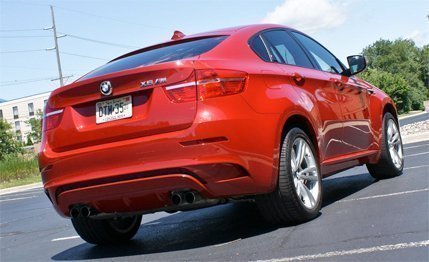
 Short Take Road Test
Short Take Road Test
There are plenty of people, including us, who wonder why BMW is building an M version of the X6. The answer seems to parallel the punch line of the joke about a canine licking himself: because he can. Also, everybody else is making a high-performance SUV. The Mercedes-Benz ML63 AMG, the Porsche Cayenne, the Infiniti FX50, and the Land Rover Range Rover Sport are all evidence that more than a few people want an SUV with a sporty on-road demeanor. This being BMW, the X6 M and its mechanically identical sibling, the X5 M, aim straight for the top of the muscle-SUV mountain. And it’s no coincidence that the two Bimmers’ 555-hp output bests that of the Porsche Cayenne Turbo S by five ponies. And just to throw more mud in Porsche’s eye, the X6 M base price of $89,725 undercuts the top Cayenne’s by $34,690.
The highlight of the X6 M is the engine with its trick exhaust manifold. Based on the 4.4-liter twin-turbo V-8 found in the X6 xDrive50i and 7-series, the M engine gets two twin-scroll Honeywell turbochargers fed by a newly patented exhaust manifold. The manifold’s tangle of piping in the valley of the V-8 routes to each scroll the exhaust from two specific cylinders. The two cylinders are 360 degrees apart in firing order, ensuring that the exhaust pulses spinning the turbos are smooth. The result is almost no turbo lag.
Unlike other M cars, there are no radical changes to the suspension and bodywork. The springs, the bushings, the anti-roll bars, and the two-stage electronic adjustable dampers are all stiffer than those of the standard X6, but the components are virtually the same. On the outside, the M model gets massive air intakes below the grille for its larger intercoolers, quad tailpipes in back, and M-badged gill vents on the front fenders.


The X6 M also keeps the six-speed automatic transmission, although the M version uses an aluminum transmission-fluid pan with cooling fins in place of the plastic pan on the regular X6. To enact quicker shifts more befitting of an M car, the engine cuts ignition and throttle to reduce the torque load during gearchanges. In standard drive mode, the transmission keeps revs below 4500 rpm to conserve fuel. Since the 500 lb-ft of torque are available as early as 1500 rpm, this efficient programming doesn’t noticeably impact normal driving.
In sport and full-on manual modes, the engine will run all the way to redline and hold gears. The X6 M also comes with a launch-control function that will handle the shifts as long as you keep the gas pedal planted to the floor. Hold your foot down for just 4.3 seconds, and you’ll see 60 mph fly by—and that is achieved without launch control enabled. With launch control, we think a tick or two could easily be shaved off. Our X6 M got to 100 mph in 10.7 seconds. For reference, the Cayenne Turbo S hits 60 in 4.4 seconds and 100 mph in 10.8. (Does that $35,000 price difference look even more substantial now?)


Amazingly, considering its 5254-pound curb weight, the X6 M does more than go fast in a straight line. Lapping the Road Atlanta racetrack during our preview drive, the X6 M flew around corners with awe-inspiring ease. It’s huge, yet it’s easy to drive quickly and displays tremendous capability. The X6 M is a glorious contradiction of a vehicle. The steering and the brakes could offer more feedback, but that’s probably a tall order for a big vehicle with 20-inch tires. But the fact that the X6 M is faster around the Nürburgring Nordschleife than the last-generation M3 pretty much says all you need to know about its overall performance. BMW says the suspension tuning for the X5 M is slightly different due to weight and balance but that it should prove just as capable as the X6 M.
Does anybody really need a Nürburgring-tuned, four-seat SUV in the first place? We’re not here to pass judgment, but we can tell you that if you want such a thing, the X6 M is the perfect choice.